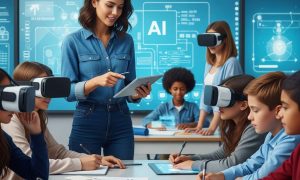The classroom of 2025 looks nothing like what many of us experienced growing up. Smart boards have replaced chalkboards. Tablets sit where textbooks once stood. AI now works alongside teachers in many K-12 schools across America. This technological shift isn’t just about fancy gadgets. It represents a fundamental change in how we approach education. Kids today are digital natives who expect technology to be part of their learning journey. School districts nationwide have noticed this shift. They’re investing in AI solutions that promise better outcomes for students. Educational institutions now view artificial intelligence as a partner rather than a threat. Teachers initially feared AI might replace them. That concern has largely faded. Most educators now see these tools as valuable allies in an increasingly complex profession. Here is how K-12 schools are embracing AI.
Personalized Learning Experiences

Learning at your own pace used to be a luxury few students enjoyed. AI has changed this reality for countless kids. Adaptive learning systems track individual progress and adjust accordingly. Students no longer move as a uniform group through material regardless of comprehension.
These personalized approaches address each student’s unique strengths and challenges. A fifth-grader struggling with fractions receives additional practice problems. Meanwhile, her classmate who mastered the concept moves on to more advanced material. Nobody feels left behind or held back.
The Khan Academy’s AI tutor exemplifies this targeted approach to education. Their system identifies knowledge gaps and creates customized learning paths. Students receive immediate feedback on their work. This instant response helps cement concepts before misconceptions take root.
Tailoring Education for Diverse Learners
Students with disabilities benefit tremendously from AI-powered tools. Text-to-speech features help those with reading difficulties. Speech recognition assists students who struggle with writing. Visual learners receive graphic representations of complex concepts.
AI doesn’t just help struggling students either. High achievers find challenges that keep them engaged through advanced material. The technology meets learners wherever they are on their educational journey. Everyone receives instruction tailored to their specific needs.
Elementary schools use these systems differently than middle or high schools. Younger children might interact with AI through game-based applications. Older students often utilize more sophisticated analytical tools. AI’s flexibility allows it to grow alongside students throughout their academic careers.
Creating Engaging Educational Content
AI tools generate practice materials that feel fresh and relevant. Gone are the days of recycling the same worksheets year after year. Teachers can create unlimited unique problems that target specific skills. Students remain engaged when the material feels current.
Interactive content captures attention in ways traditional methods cannot. Virtual field trips transport students to ancient Rome or inside a human cell. Simulations let them experiment without risk. These experiences stick with kids long after the lesson ends.
The best AI educational content blends engagement with substance. Flashy graphics alone don’t improve learning outcomes. Thoughtful design based on educational research makes the difference. Schools are becoming more discerning about which AI tools truly enhance learning.
Enhancing Teacher Efficiency
Teachers typically spend hours grading papers each week. AI can complete this task in minutes. Automatic assessment of multiple-choice and short-answer questions saves valuable time. Educators can focus on providing meaningful feedback instead of tallying points.
Planning lessons consumes another significant chunk of a teacher’s schedule. AI suggests relevant resources based on curriculum standards. It generates starter activities and discussion questions. These tools don’t replace teacher creativity but enhance it.
Administrative paperwork has traditionally burdened educators. AI simplifies many of these processes. Attendance tracking, parent communication, and data analysis happen almost automatically. The technology handles routine tasks while humans manage the nuanced aspects of education.
Streamlining Assessment and Feedback
Grading essays once required hours of careful reading. AI can now evaluate writing samples for grammar, structure, and content. Teachers review these assessments and add personal insights. The combination proves more efficient than either approach alone.
Immediate feedback helps students correct misconceptions quickly. AI systems identify patterns in student errors. They suggest targeted interventions based on these patterns. Teachers receive comprehensive data about class performance without manual analysis.
AI analysis has improved standardized test preparation. Programs identify which concepts require additional review. They create personalized study plans for each student. Teachers use this information to adjust their instruction before high-stakes assessments.
Supporting Administrative Functions
Scheduling parent conferences used to involve countless emails and phone calls. AI systems now handle these logistics automatically. They find optimal times based on everyone’s availability. This efficiency extends to staff meetings and professional development sessions.
Budget management benefits from AI predictive analytics. Schools forecast resource needs with greater accuracy. They allocate funds more effectively. These financial tools help stretch limited educational dollars further than ever before.
Student information systems powered by AI track attendance and behavioral patterns. They alert staff to potential issues before they become serious problems. Early intervention leads to better outcomes. Teachers appreciate this proactive approach to student support.
Curriculum Development and AI Literacy
Modern curriculum must prepare students for an AI-driven future. Schools increasingly incorporate computational thinking across subjects. These skills help students understand how AI works. They learn to be creators rather than mere consumers of technology.
Critical thinking receives renewed emphasis in this technological landscape. Students must evaluate information sources critically. They need to recognize the limitations of AI-generated content. These analytical skills serve them well regardless of their chosen career path.
Ethical considerations around AI use become part of classroom discussions. Students explore questions about privacy, bias, and automation. They develop nuanced perspectives on these complex issues. This preparation helps them navigate an increasingly automated world.
Teaching AI Concepts Across Grade Levels
Elementary students learn basic programming concepts through games and visual interfaces. They discover how computers follow instructions. Simple robots introduce algorithmic thinking in accessible ways. These foundational experiences build technological confidence.
Middle school curricula often include more sophisticated coding projects. Students create basic AI applications that solve real problems. They learn about data collection and analysis. These activities connect abstract concepts to practical applications.
High school courses dive deeper into the mathematics behind AI systems. Students explore neural networks and machine learning principles. Some schools offer specialized AI courses or certification programs. These opportunities prepare students for postsecondary education in technology fields.
Developing Digital Literacy Skills
Information literacy takes on new importance in the age of generative AI. Students learn to distinguish between credible and questionable sources. They recognize machine-generated content. These skills help them navigate an increasingly complex information landscape.
Media literacy education helps students understand how AI influences what they see online. They analyze targeted advertising and recommendation algorithms. Critical consumption of digital content becomes a crucial life skill. Schools integrate these lessons across the curriculum.
Technical literacy ensures students can use AI tools effectively and responsibly. They learn about data privacy and digital citizenship. Hands-on experience with various platforms builds practical knowledge. This preparation serves them well beyond graduation.
Challenges and Ethical Considerations
The digital divide threatens to widen educational inequality. Affluent schools implement sophisticated AI systems. Meanwhile, low-income districts struggle with basic technology access. This disparity demands attention from policy makers and educational leaders.
Privacy concerns arise as AI systems collect student data. Questions about who owns this information and how it’s used remain contentious. Schools must balance the benefits of personalized learning with proper safeguards. Transparent policies help address parental concerns.
Over-reliance on technology poses another significant challenge. Human interaction remains essential to social development. Students need face-to-face collaboration and discussion. Finding the right balance requires thoughtful implementation of AI tools.
Addressing Equity and Access Issues
Rural schools face unique challenges implementing AI solutions. Limited internet connectivity restricts online learning options. Smaller budgets constrain technology purchases. Creative approaches like offline AI applications help bridge these gaps.
Socioeconomic factors impact technology access at home. Schools must ensure all students can complete technology-based assignments. Some districts provide equipment for home use. Others extend library hours for computer access after school.
Language barriers affect some students’ ability to benefit from English-only AI platforms. Multilingual options remain limited in educational technology. Districts with diverse populations advocate for more inclusive tools. They work with developers to address these shortcomings.
Maintaining Human Connection in Education
Teachers worry about diminished personal relationships in technology-rich environments. They strive to preserve meaningful human connections. The most successful schools use AI to enhance rather than replace personal interaction. Technology serves as a tool rather than the focus.
Social-emotional learning requires human guidance and modeling. AI cannot teach empathy or conflict resolution effectively. Schools recognize these limitations. They design hybrid approaches that leverage technology while preserving essential human elements.
Finding the proper balance varies by grade level and subject area. Mathematics might benefit from more AI-driven practice, and literature discussions thrive with minimal technology intervention. Thoughtful integration respects these differences rather than applying one-size-fits-all solutions.
Conclusion
AI has already transformed K-12 education in meaningful ways. Students benefit from personalized learning experiences, teachers gain valuable time for meaningful interaction, and the curriculum evolves to prepare young people for an increasingly automated world.
The journey has just begun. Tomorrow’s classrooms will incorporate technologies we can hardly imagine today. Educational leaders must stay informed about emerging possibilities. They need to evaluate new tools critically rather than chasing every trend.
Success ultimately depends on thoughtful implementation. Technology should serve educational goals rather than driving them. The human elements of teaching and learning remain irreplaceable. Schools that remember this principle will thrive in the AI era.
The future looks promising for K-12 education. AI offers solutions to longstanding challenges. It opens doors previously closed to many students. With careful planning and ethical implementation, these tools will help prepare the next generation for whatever lies ahead.
Also Read: Best Prague Neighborhoods for Students FAMU
FAQs
Personalized learning experiences that adapt to individual student needs and pace.
No, AI serves as a tool to enhance teaching, not replace the human connection essential to education.
Equity issues, privacy concerns, technical limitations, and maintaining appropriate human interaction.
Schools incorporate computational thinking across subjects and offer specific courses on AI concepts appropriate for each grade level.




